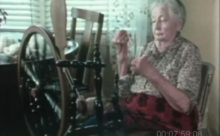Tradition Bears Bio of Katri Saari, weaver
Katri Saari, Spinning and Weaving Folk Artist Biography
In a corner of the weaving demonstration room at the Minnesota Discovery Center in Chisholm, Minnesota, is a cutout photo of an elderly woman, hair pulled back in a bun, arms crossed, 4’10” inches in height. She appears to be gazing at a large wooden rug loom, which happens to bear her name: the Katri Saari Loom.
Katri Saari was born on April 17, 1893, the eldest of ten children to be born to Ernst and Josefiina Laakkonen, tenant farmers in Nivala, Finland. Her father was an itinerant tailor, and it was from him that, before she was 10, she learned the seamstressing trade to help support her family. In her birth home she also learned the traditional and practical arts of weaving and spinning wool.
At the age of 20, on her own and looking for the land of gold, she left Finland. She entered into the United States at Sault Ste. Marie, Michigan, on August 23, 1913, via the Canadian Pacific Railway. The train carried her to Duluth, where she was met by the person who had paid her passage and was transported to his nearby farm where she did farm women’s duties for a year to pay off her debt.
From there, she travelled to Virginia, Minnesota, where she worked in the kitchen of a boarding house and later as a cook for a well-to-do Virginia family. She was courted by Gust Saari, a native of Kuortane, Finland, who worked as an underground miner. They married in 1917; two children, Vienna and Edwin, were born to them in Virginia. In 1922 the family moved to an 80-acre farm in Idington, Minnesota, and they took up the life of subsistence dairy farmers. There she partnered with her husband: she milked cows, made butter, made Finnish-style “squeaky cheese”, sewed clothes, raised a garden, picked berries, preserved food, baked bread.
Gust died in 1952, and Katri was left a widow at the age of 60. She continued to operate the farm with her son Edwin, who never married. She named the farm “Kallionkolo” (Hollow in the Hills) and lived there until a few months before her death in December 1984 at the age of 91.
In 1922 a cooperative share ownership in a handmade wooden rug loom came with the land. The loom would be transported from home to home so that rugs could be woven in each of the five co-owners’ homes. She became the last surviving owner and the loom took up residence at her home for (perhaps) 25 years. She began experimenting with weaving decorative patterns with four-ply commercial knitting yarn. She received some weaving patterns from relatives in Finland.
Though she had learned to spin wool in Finland, she did not take up the art of spinning again until after she decided she would no longer help in the barn. She ordered a spinning wheel from Finland. In her retirement, she gave demonstrations and taught the art of spinning and weaving to others.
Folk Art Achievements and Recognition
In a corner of the weaving demonstration room at the Minnesota Discovery Center in Chisholm, Minnesota, is a cutout photo of an elderly woman, hair pulled back in a bun, arms crossed, 4’10” inches in height. She appears to be gazing at a large wooden rug loom, which happens to bear her name: the Katri Saari Loom.
